"Painting is an attempt, to approach God." Thengis Rioni
Each thing ist followed by its counterpart like a shadow in the aftermath of light -
Thengis Rioni's imagery between exotic worlds and philosophy
The Georgian painter and sculptor Thengis chose the name of the river Rioni - which runs through his hometown - as a surname. Rioni is more than just a name, it is a parable. Heraklit said that a man cannot step into the same river twice. The moment 's clearness is blurred by the running water just as it is by passing time. Thengis' pictures have an effect on the viewer like the river which gradually passes over and disolves the stone.
Calm composure dominates these pictures. lt soothes the senses and makes the spirit pensive. They infold more than the first glance tells. The secret of these images is revealed when their magic starts to work. Their mystery is the mystery of all being: the equivocalness, the paradox the ambiguity, the elapsing. Each thing is followed by its counterpart like a shadow in the aftermath of light.
The bright sunlight, the subtle change of seasons, the opulent nature and the warm colours of Thengis' Georgian home can be found in his works. The senses are caught up in the magic of the strangeness and exotic in his portraits still lifes and landscapes. The almond-shaped eyes, the intensive warm colours and a certain kind of stylization give a picture of Thengis Rioni 's roots in the Georgian folkloristic tradition. This relation to tradition is, however, broken by the influence of the modern. Already in the first decades of the twentieth century Georgian painting sought a link to the European modern. The painters Elena Achwlediani ( 1898 - 1975) and Niko Pirosmani ( 1862 - 1918) represent this process. Also Thengis feels bound to the aesthetic of the modern.
However, the artist holds a distance to radical experiments with forms and the dissolution of objects. He remains loyal to the realistic movement. But we recognize the influence of the modern - in the spacial solution, in the cubistic discontinuity and the transparency of forms in elements of simultaneousness and variations, in the coexistence of real and surreal, in the distortion of special structures and anatomical proportions and in a subtle expulse with the elements of naive art.
For this exchanging of the picture's optics Thengis seems to have found examples in the masters of European realism: in Girolamo Francesco Mazzola, named Parmigianino (1503-1540) - of whom Vasari said he painted so life-like that it was unbelievable -, in Amedeo Modigliani (1884-1920), in Marc Chagall (1887-1985), and in Otto Dix (1891-1969). The coexistence and exchange of traditional and modern influence builds up an interesting and suspenseful tension in Thengis Rioni's works.
As one born in the month of August, Thengis Rioni has a special love for warm colours. The dominant colors in his works are red, yellow and white. They influence each other and are influenced themselves by the change of seasons, the change of lighting. Delicate transitions and contrasts from light to dark and dark to light are characteristic for his pictures. The subject determines the path of the transition. The secret of this particular kind of effect lies, however, in the painter's special technique. The contrasts only function in this way because of the different filmy colour layers painted over each other. During this process the handling of brush the use of a spatula, fingers and the entire hand play a determined role. One could call this technique a "modelling with colour".
We already have pointed out the fact that Thengis Rioni's pictures express an obligation to modern realism. This realism needs to be specified by an adjective. It seems appropriate to use the terms 'magic' or 'romantic' realism. The magic lies in the fascination these pictures evoke. They don ' t try to provoke nor accuse, they don ' t force an "Ecce homo!" onto the world. lt is just the quiet that upsets the viewer the calmness is disturbing. Rather they whisper, "This is youl" they reveal cautiously the horror and the comfort of the "Conditio humana". The viewer feels the artist's secret passion for philosophy and psychology.
This is shown in a remarkable way in the picture ''The Philosopher'' (200l). The philosopher seems to be at peace with his own knowledge of the world. Calmness, almost boredom can be seen in his eyes, they look inwards. The pipe is stuck nonchalantly in the corner of his mouth. Still this is not an idyll, there is no fulfilment in seclusion. Contradictions are disclosed. The large head of the philosopher has an astonishingly underdeveloped forehead. Instead the ears are quite big. The philosopher who had just seemed to be totally callm, now shows signs of uncertainty, even fear. He has his ears perked up - just like a hare - listening anxiously to the world. His knowledge is seemingly dissolving in view of the paradoxes of life.
Thengis' realism is also "romantic" because he opens up frontiers between inside and outside, between man and nature, the concrete and the imaginary, real life and phantasy, fairytale and reality, repletion and unconsciousness, poetry and painters. The picture "Loving Trees" (2003) symbolizes this romantic programme - by letting the nature seem to be human, human love becomes an eternal element in the universe.
Thengis Rioni is also a great visual narrator and poet. His painted stories of everyday life refer to the paradoxical character of all being. The painting "The Ballet-dancers" (2003) is based upon a true story. It is the image of a talented dancer whose success is secretly envied. At first glance the two women in the picture seem to represent an orgy of beauty and happiness. But then, suddenly, the conflict is revealed. The face of the successful woman - totally lit up - smiles at the viewer modestly and happily, the rival is only seen in half profile. It is not only the view of the other woman ' s profile lying in the dark - seemingly supple, approaching the other - that is disturbing, but also her soul appears to be enticed with dark, revengeful thoughts.
The ''romantic'' in his realism appears too in the boundless glorification of the feminine. Women are Thengis Rioni's favorite subject. Looking at fascination which the female body, the female beauty, their eroticism and way of being exerts on him. This part of his work could be seen as work searching for the mystery of the female nature. Discreet but still exact. revealing but never embarrassing, through his painting he approaches the abundance of the many facets of a woman in their widest variety.
In "Young Philosopher" (2003), Thengis shows us both feminine wisdom and girlish naivety. The young philosopher is immersed in thought over the basic question of philosophy - the question of the origins of being. She is holding both a hen and an egg in her hands, lost in silent consideration. Wisdom often lies in the determined rejection of a decision.
In the picture "The Horsewoman's Dream" (2003) we are confronted with the inacessibility of female erotic phantasies. Will the horsewoman be seduced by the young man's yearning melody or is she herself - Aphrodite on her high horse - the actual master of eros?
"Two Sides Of Life" (2002), formally an artistic homage to the futuristic simultaneity in the corporation of bodies, shows both ambivalent female conditions which seem to escape the curious glance of the male voyeur. Seemingly incidentally, the painted irony and the delicately modelled humour in Thengis Rioni's pictures charm the attentive viewer.
"The 21st Century" (2003) - this portrait of an actress - again shows self-confident feminity radiant in a beautiful sunset as an icon of the new century. Emancipation is also the male 's pleasure - this could be a message of this painting.
Thengis Rioni 's paintings are images of Ionging, of beauty and of contemplation. They seem to be coming from a faraway almost forgotten world. Europe's center, as a philosopher just said recently - lies in the east, closer to the Caucasus than we imagine. Thengis Rioni brings his images to uns from this close yet faraway land and we can discover ourselves again and again in their exotic strangeness the longer we look at them in detail.
(Hans Christian Förster, translated by Anneke Gerloff)
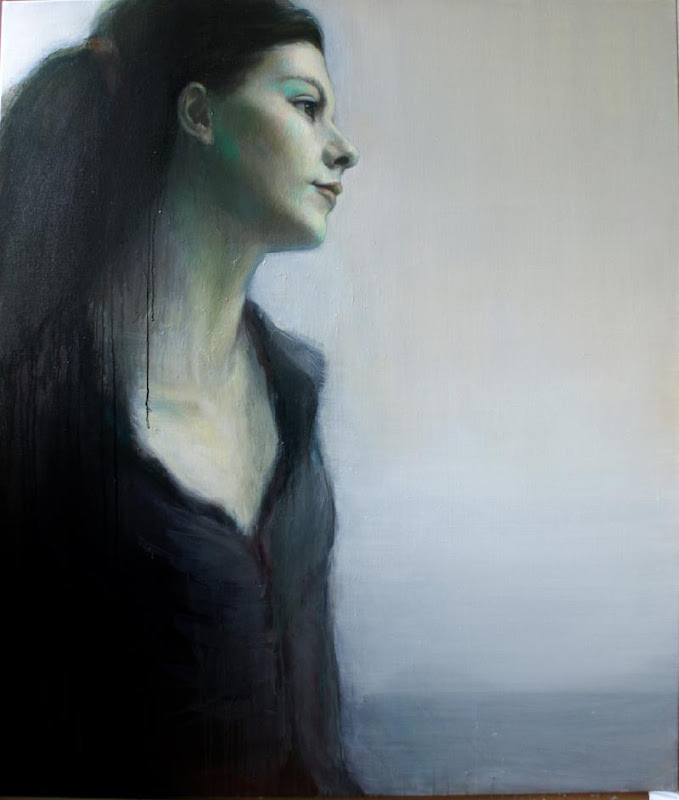
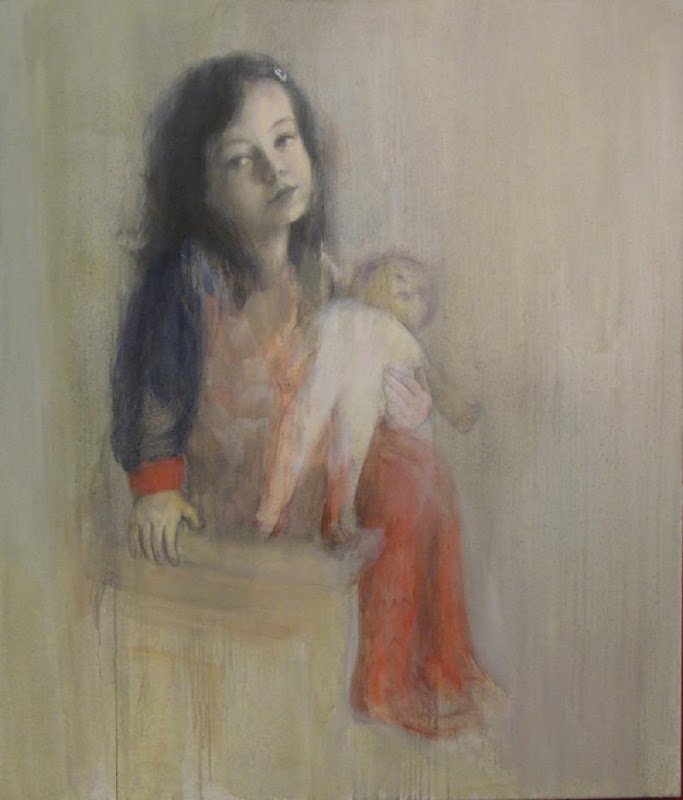
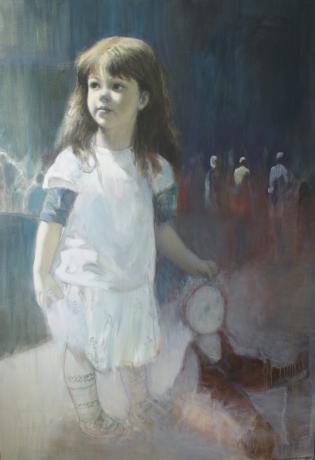

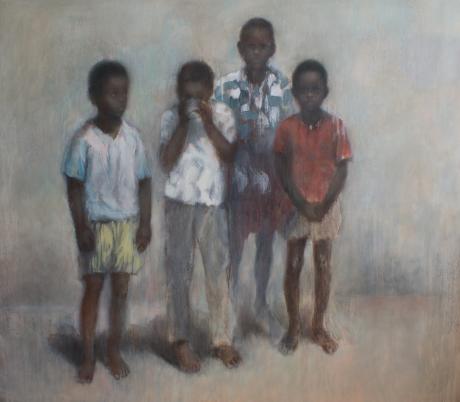
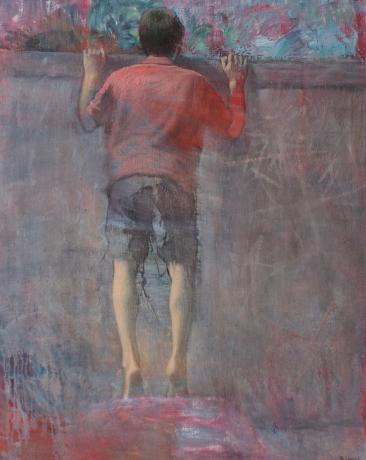
Each thing ist followed by its counterpart like a shadow in the aftermath of light -
Thengis Rioni's imagery between exotic worlds and philosophy
The Georgian painter and sculptor Thengis chose the name of the river Rioni - which runs through his hometown - as a surname. Rioni is more than just a name, it is a parable. Heraklit said that a man cannot step into the same river twice. The moment 's clearness is blurred by the running water just as it is by passing time. Thengis' pictures have an effect on the viewer like the river which gradually passes over and disolves the stone.
Calm composure dominates these pictures. lt soothes the senses and makes the spirit pensive. They infold more than the first glance tells. The secret of these images is revealed when their magic starts to work. Their mystery is the mystery of all being: the equivocalness, the paradox the ambiguity, the elapsing. Each thing is followed by its counterpart like a shadow in the aftermath of light.
The bright sunlight, the subtle change of seasons, the opulent nature and the warm colours of Thengis' Georgian home can be found in his works. The senses are caught up in the magic of the strangeness and exotic in his portraits still lifes and landscapes. The almond-shaped eyes, the intensive warm colours and a certain kind of stylization give a picture of Thengis Rioni 's roots in the Georgian folkloristic tradition. This relation to tradition is, however, broken by the influence of the modern. Already in the first decades of the twentieth century Georgian painting sought a link to the European modern. The painters Elena Achwlediani ( 1898 - 1975) and Niko Pirosmani ( 1862 - 1918) represent this process. Also Thengis feels bound to the aesthetic of the modern.
However, the artist holds a distance to radical experiments with forms and the dissolution of objects. He remains loyal to the realistic movement. But we recognize the influence of the modern - in the spacial solution, in the cubistic discontinuity and the transparency of forms in elements of simultaneousness and variations, in the coexistence of real and surreal, in the distortion of special structures and anatomical proportions and in a subtle expulse with the elements of naive art.
For this exchanging of the picture's optics Thengis seems to have found examples in the masters of European realism: in Girolamo Francesco Mazzola, named Parmigianino (1503-1540) - of whom Vasari said he painted so life-like that it was unbelievable -, in Amedeo Modigliani (1884-1920), in Marc Chagall (1887-1985), and in Otto Dix (1891-1969). The coexistence and exchange of traditional and modern influence builds up an interesting and suspenseful tension in Thengis Rioni's works.
As one born in the month of August, Thengis Rioni has a special love for warm colours. The dominant colors in his works are red, yellow and white. They influence each other and are influenced themselves by the change of seasons, the change of lighting. Delicate transitions and contrasts from light to dark and dark to light are characteristic for his pictures. The subject determines the path of the transition. The secret of this particular kind of effect lies, however, in the painter's special technique. The contrasts only function in this way because of the different filmy colour layers painted over each other. During this process the handling of brush the use of a spatula, fingers and the entire hand play a determined role. One could call this technique a "modelling with colour".
We already have pointed out the fact that Thengis Rioni's pictures express an obligation to modern realism. This realism needs to be specified by an adjective. It seems appropriate to use the terms 'magic' or 'romantic' realism. The magic lies in the fascination these pictures evoke. They don ' t try to provoke nor accuse, they don ' t force an "Ecce homo!" onto the world. lt is just the quiet that upsets the viewer the calmness is disturbing. Rather they whisper, "This is youl" they reveal cautiously the horror and the comfort of the "Conditio humana". The viewer feels the artist's secret passion for philosophy and psychology.
This is shown in a remarkable way in the picture ''The Philosopher'' (200l). The philosopher seems to be at peace with his own knowledge of the world. Calmness, almost boredom can be seen in his eyes, they look inwards. The pipe is stuck nonchalantly in the corner of his mouth. Still this is not an idyll, there is no fulfilment in seclusion. Contradictions are disclosed. The large head of the philosopher has an astonishingly underdeveloped forehead. Instead the ears are quite big. The philosopher who had just seemed to be totally callm, now shows signs of uncertainty, even fear. He has his ears perked up - just like a hare - listening anxiously to the world. His knowledge is seemingly dissolving in view of the paradoxes of life.
Thengis' realism is also "romantic" because he opens up frontiers between inside and outside, between man and nature, the concrete and the imaginary, real life and phantasy, fairytale and reality, repletion and unconsciousness, poetry and painters. The picture "Loving Trees" (2003) symbolizes this romantic programme - by letting the nature seem to be human, human love becomes an eternal element in the universe.
Thengis Rioni is also a great visual narrator and poet. His painted stories of everyday life refer to the paradoxical character of all being. The painting "The Ballet-dancers" (2003) is based upon a true story. It is the image of a talented dancer whose success is secretly envied. At first glance the two women in the picture seem to represent an orgy of beauty and happiness. But then, suddenly, the conflict is revealed. The face of the successful woman - totally lit up - smiles at the viewer modestly and happily, the rival is only seen in half profile. It is not only the view of the other woman ' s profile lying in the dark - seemingly supple, approaching the other - that is disturbing, but also her soul appears to be enticed with dark, revengeful thoughts.
The ''romantic'' in his realism appears too in the boundless glorification of the feminine. Women are Thengis Rioni's favorite subject. Looking at fascination which the female body, the female beauty, their eroticism and way of being exerts on him. This part of his work could be seen as work searching for the mystery of the female nature. Discreet but still exact. revealing but never embarrassing, through his painting he approaches the abundance of the many facets of a woman in their widest variety.
In "Young Philosopher" (2003), Thengis shows us both feminine wisdom and girlish naivety. The young philosopher is immersed in thought over the basic question of philosophy - the question of the origins of being. She is holding both a hen and an egg in her hands, lost in silent consideration. Wisdom often lies in the determined rejection of a decision.
In the picture "The Horsewoman's Dream" (2003) we are confronted with the inacessibility of female erotic phantasies. Will the horsewoman be seduced by the young man's yearning melody or is she herself - Aphrodite on her high horse - the actual master of eros?
"Two Sides Of Life" (2002), formally an artistic homage to the futuristic simultaneity in the corporation of bodies, shows both ambivalent female conditions which seem to escape the curious glance of the male voyeur. Seemingly incidentally, the painted irony and the delicately modelled humour in Thengis Rioni's pictures charm the attentive viewer.
"The 21st Century" (2003) - this portrait of an actress - again shows self-confident feminity radiant in a beautiful sunset as an icon of the new century. Emancipation is also the male 's pleasure - this could be a message of this painting.
Thengis Rioni 's paintings are images of Ionging, of beauty and of contemplation. They seem to be coming from a faraway almost forgotten world. Europe's center, as a philosopher just said recently - lies in the east, closer to the Caucasus than we imagine. Thengis Rioni brings his images to uns from this close yet faraway land and we can discover ourselves again and again in their exotic strangeness the longer we look at them in detail.
(Hans Christian Förster, translated by Anneke Gerloff)












